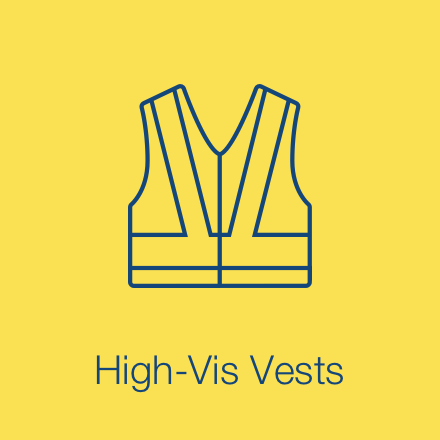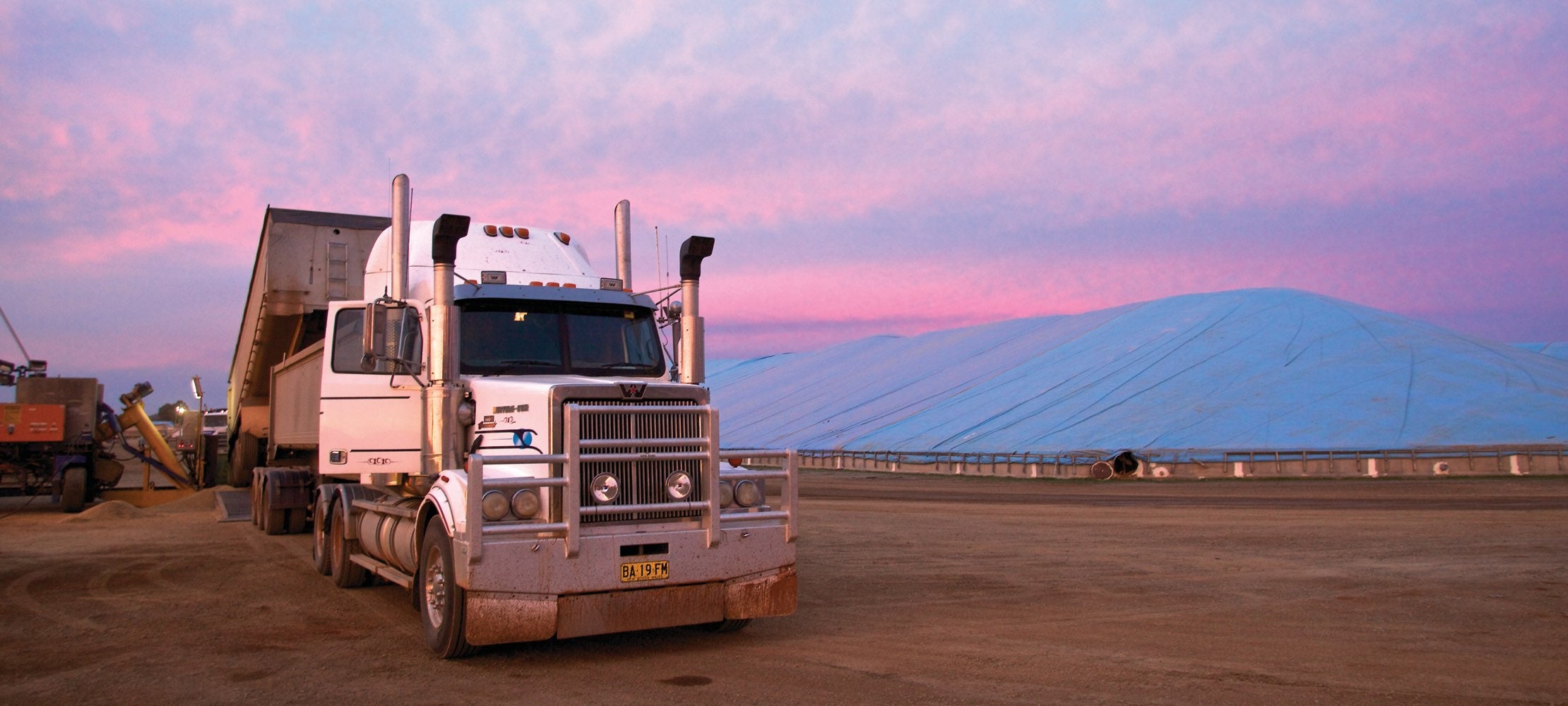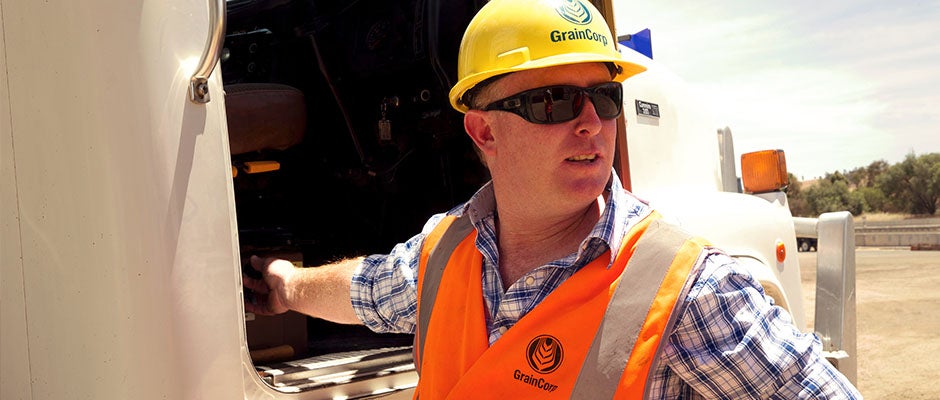Your safety checklist
GrainCorp’s number one priority at our sites is safety – yours and ours
Don’t have your own Personal Protection Equipment?*





Our safety standards mandate that Personal Protection Equipment (PPE) is required to be worn when you are on site:
NOTE: No less than P2 level dust masks must be worn when exposed to airborne dust. In addition, safety glasses and, when required, goggles are to be worn. You must also wear hearing and UV protection when instructed. The best protection for feet and ankles are lace-up steel cap boots.
*Don't have your own PPE? We can lend you the essentials; collect at the sample stand or site office.
Report to the sample stand or site office on arrival, and:
All trucks delivering grain to GrainCorp sites are responsible for:
Note: Convertible tipper-trailers complying with the above points are permitted to deliver.
Everyone on GrainCorp sites must be 100% free from alcohol or illegal, prescription or pharmaceutical drugs that may affect their ability to safely perform their duties. Anyone who presents at a GrainCorp site in the presence of, or impaired, by drugs and alcohol will not be permitted on site. As a visitor you may be subjected to Drug and Alcohol Testing.

The Heavy Vehicle National Laws and associated Chain of Responsibility (CoR) obligations apply to all participants in the road transport supply chain.
During the harvest period, mass and fatigue are two significant areas where growers, road transport providers and receivers of grain could be legally liable for breaches of road transport laws.
In the event of breaches, both the truck driver and loader could face heavy penalties.
Under the CoR Legislation, grain receivers in every state can be compelled to provide detailed information in relation to deliveries received.
This information can and has been used by regulators to prosecute transport contractors and growers.
From 1 October 2018 the Heavy Vehicle National Law expanded to include vehicle maintenance.
Practically, the law continues to oblige the grain industry to manage our risks when moving grain on the road with trucks.
For further information, please refer to the National Heavy Vehicle Regulator website: www.nhvr.gov.au

Mass limits apply to heavy vehicles. During harvest, mass management laws apply to growers and truck drivers alike.
Whether loading the trucks on-paddock or driving the truck to a GrainCorp site, it is everyone’s responsibility to ensure the truck complies with mass limits.
Mass limits apply to the truck configurations used by growers during harvest and these mass limits vary in every state.
When loading grain it is important that the mass limit, Gross Vehicle Mass (GVM) and Gross Combination Mass (GCM) is known and not exceeded.
The default mass limit is the General Mass Limit (GML). On top of GML, trucks are also able to apply for extra mass limits that fall into the following categories:
In 2018, GrainCorp implemented the Grain Transport Safety Network Truck Chart and in 2020, GrainCorp expanded this with a corresponding Truck Book. Both the chart and book can be found at www.gtsn.com.au.
Mass limits for all vehicles can be found on the National Heavy Vehicle Regulator website: www.nhvr.gov.au
GrainCorp has been working with state regulators to make it easier for growers to load on-farm and deliver grain to their local site during harvest. There are differences between state jurisdictions for overloaded vehicles:
Queensland. The GHMS is administered by AgForce Queensland in conjunction with Transport and Main Roads (TMR). Registered grower trucks, transport providers and receivers of bulk grain receive a mass limit increase of up to 7.5 percent from the General Mass Limit. No increase applies to trucks claiming CML, HML or PBS.
In 2020, the requirement for GrainCorp to reject very heavy trucks no longer applies, which is replaced by more frequent reporting to TMR. Trucks that exceed the mass limit in Queensland may be removed from the scheme by TMR.
NSW. Most truck types receive an increased mass limit of up to 5 percent above General Mass Limit, however you should always check your truck type and area with RMS to ensure your load is legal.
Council participation is optional, so it is important that you understand what mass limits apply for your area. GrainCorp must unload trucks within their usual legal mass limit if councils do not participate. Further information is available at the RMS website:
www.rms.nsw.gov.au/business-industry/heavy-vehicles/grain-transport.html
Victoria. Trucks receive an increased mass limit of up to 5 percent above General Mass Limit if they comply with the scheme.
For further information, refer to the VicRoads website: https://www.vicroads.vic.gov.au/business-and-industry/heavy-vehicle-industry/farmer-and-agricultural-information/grain-harvest-management-scheme
Harvest Overload Management. For harvest 2020/21, GrainCorp will continue to complement warning notices given to truck drivers that exceed the mass limit with emails and notifications, using GrainCorp’s CropConnect system.
For more information on Harvest Overload Management, click here.

Fatigue management laws apply to vehicles with a Gross Vehicle Mass of 12 or more tonnes.
Most truck drivers delivering to GrainCorp sites would operate under ‘Standard Hours’ where they can work a maximum of 12 hours per 24-hour period, and must take minimum rest breaks and rest days as per the table below.
Further information on fatigue management can be found at the National Heavy Vehicle Regulator website.
Log Books
All drivers of regulated heavy vehicles who drive 100km or more from their home base, or operate under Basic Fatigue Management or Advanced Fatigue Management, must complete a work diary to record their work and rest times unless they have a work diary exemption.
The National Primary Producer Production Work Diary Exemption (Notice) 2015 allows primary producers to drive 160km from their home base before log books are required in New South Wales, Queensland, South Australia and Victoria.
If you or a truck driver/subcontractor you employ is working in an area less than the above distances from the home base and Standard Hours are used, a log book is not required. When working without a log book, relevant work and rest hour totals records must be kept.
Further information on log books can be found at the National Heavy Vehicle Regulator website: www.nhvr.gov.au
| Time | Work | Rest | |
|---|---|---|---|
Time: In any period of... Work: A driver must not work for more than a maximum of... Rest: And must have the rest of that period of work with at least a minimum rest break of... | In any period of... | A driver must not work for more than a maximum of... | And must have the rest of that period of work with at least a minimum rest break of... |
Time: 5.5 hours Work: 5.25 hours work time Rest: 15 continuous minutes rest time | 5.5 hours | 5.25 hours work time | 15 continuous minutes rest time |
Time: 8 hours Work: 7.5 hours work time Rest: 30 minutes rest time in blocks of 15 continuous minutes | 8 hours | 7.5 hours work time | 30 minutes rest time in blocks of 15 continuous minutes |
Time: 11 hours Work: 10 hours work time Rest: 60 minutes rest time in blocks of 15 continuous minutes | 11 hours | 10 hours work time | 60 minutes rest time in blocks of 15 continuous minutes |
Time: 24 hours Work: 12 hours work time Rest: 7 continuous hours stationary rest time* | 24 hours | 12 hours work time | 7 continuous hours stationary rest time* |
Time: 7 days Work: 72 hours work time Rest: 24 continuous hours stationary rest time | 7 days | 72 hours work time | 24 continuous hours stationary rest time |
Time: 14 days Work: 144 hours work time Rest: 2 x night rest breaks# and 2 x night rest breaks taken on consecutive days | 14 days | 144 hours work time | 2 x night rest breaks# and 2 x night rest breaks taken on consecutive days |
* Stationary rest time is the time a driver spends out of a heavy vehicle or in an approved sleeper berth of a stationary heavy vehicle.
# Night rest breaks are 7 continuous hours stationary rest time taken between the hours of 10pm on a day and 8am on the next day or 24 continuous hours stationary rest break.
Further information on fatigue management can be found at the National Heavy Vehicle Regulator website
We use cookies to give you the best experience of our website. We use essential non-privacy intrusive cookies which are necessary for the operation of the website as well as non-essential cookies to optimise your experience. Read our cookie policy